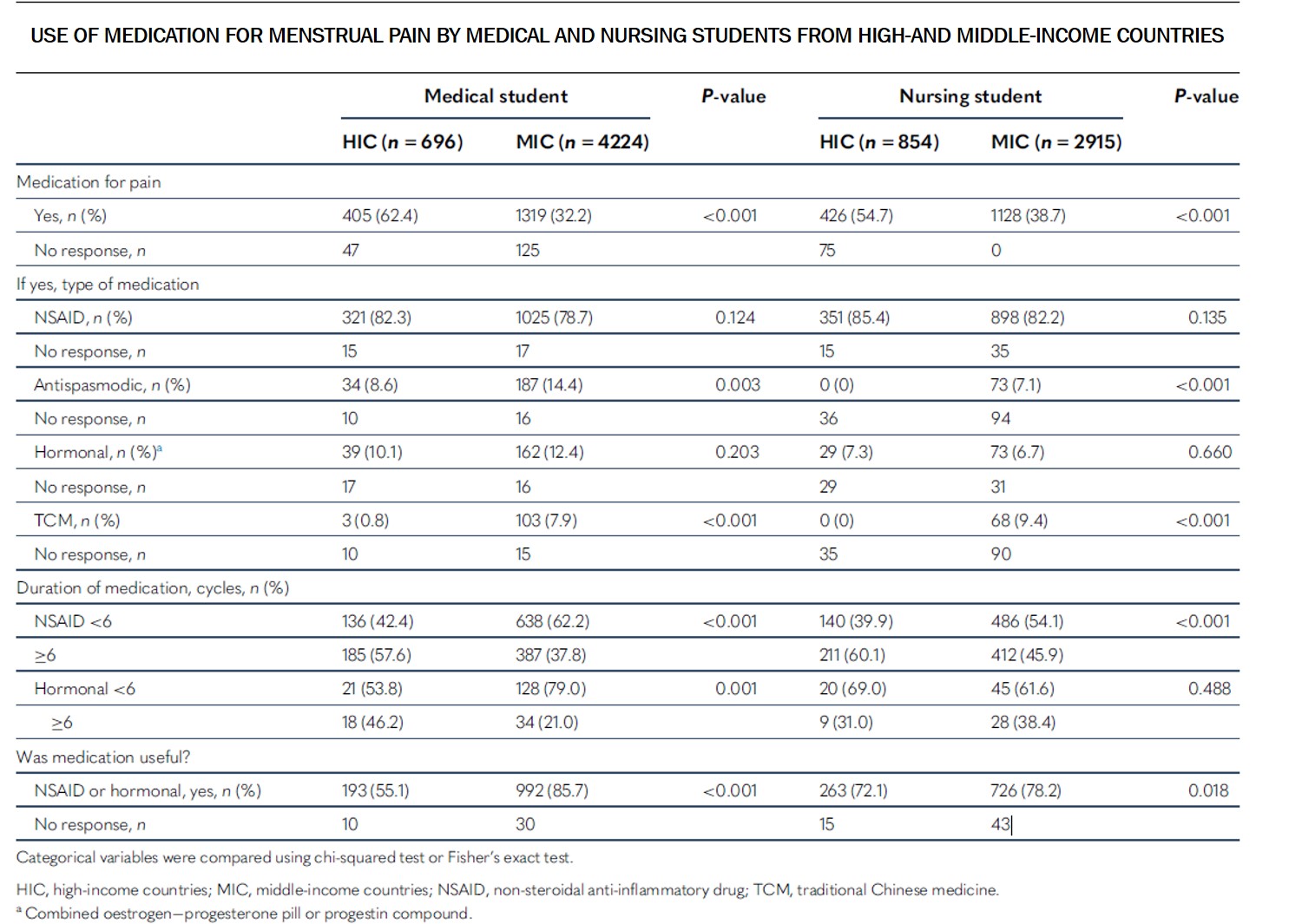
Highlight
การศึกษานี้ในนักศึกษาหญิงจากคณะแพทย์และพยาบาลจากประเทศที่มีรายได้สูง และรายได้ปานกลาง พบว่าการปวดประจำเดือนรุนแรงถือเป็นปัจจัยเสี่ยงสูงที่จะพัฒนาไปเป็นเยื่อบุโพรงมดลูกเจริญผิดที่ได้ นอกจากนี้จากการวิเคราะห์หลายตัวแปรพบว่าการมีประจำเดือนเร็ว ค่าดัชนีมวลกายต่ำ และคนในครอบครัวมีประวัติของอาการปวดประจำเดือนมีความเสี่ยงสูงที่จะเป็น เยื่อบุโพรงมดลูกเจริญผิดที่ได้
ที่มาและความสำคัญ
Endometriosis หรือเยื่อบุโพรงมดลูกเจริญผิดที่ เป็นภาวะที่มีเซลล์เยื่อบุโพรงมดลูกไปเจริญภายนอกมดลูก ภาวะนี้ส่งผลให้เกิดปัญหาทางสุขภาพของผู้หญิงได้แก่การปวดประจำเดือนรุนแรง ภาวะมีบุตรยากและการกลับเป็นซ้ำหลังการรักษาหรือแม้แต่กระทั่งสามารถกลายเป็นมะเร็งได้ ปัจจุบันยังไม่สามารถหาสาเหตุของการเกิดเยื่อบุโพรงมดลูกเจริญผิดที่ที่แน่ชัดได้ ด้วยเหตุนี้การรักษาเยื่อบุโพรงมดลูกเจริญผิดที่จึงเป็นการรักษาอาการและเพื่อแก้ไขปัญหาของผู้ป่วย เช่น การใช้ยาฮอร์โมนต่าง ๆ เพื่อลดอาการปวด และการผ่าตัดซึ่งสามารถช่วยให้แก้ไขภาวะมีบุตรยาก อย่างไรก็ตามในปัจจุบันภาวะนี้ยังไม่มียาหรือการรักษาที่ได้ผลดีเนื่องจากผู้ป่วยส่วนใหญ่จะมีการกลับมาเป็นซ้ำได้ หลังจากการให้ยาหรือการผ่านำรอยโรคออกมาแล้ว ดังนั้นการตรวจพบผู้ที่มีความเสี่ยงแต่เนิ่น ๆ รวมถึงการจัดการที่เหมาะสมอย่างทันท่วงที จึงเป็นสิ่งที่สำคัญในการป้องกันการเจริญของเยื่อบุโพรงมดลูกเจริญผิดที่ เพราะฉะนั้นการศึกษานี้จึงเป็นการศึกษารูปแบบการปวดประจำเดือน ผลของการใช้ยา และวิเคราะห์ความเสี่ยงในการเป็นเยื่อบุโพรงมดลูกเจริญผิดที่ในกลุ่มนักศึกษาแพทย์และนักศึกษาพยาบาลจากประเทศที่มีรายได้สูง และประเทศที่มีรายได้ปานกลาง
Abstract
Research question
Do patterns of the menstrual cycle, menstrual pain and the use of medication for menstrual pain differ between young women from high-income countries (HIC) and middle-income countries (MIC)?
Design
A multinational, multicentre, cross-sectional study using pen-and-paper questionnaires was conducted between 2016 and 2021 to assess patterns of the menstrual cycle, menstrual pain and the use of medication for menstrual pain. Various parameters were evaluated to identify high-risk factors for severe menstrual pain in women from two HIC (n = 1550) and nine MIC (n = 7139).
Results
From a total of 9114 young women, 4920 medical students (HIC n = 696, MIC n = 4224) and 3769 nursing students (HIC n = 854, MIC n = 2915) were included in this study. Compared with those from HIC, a significantly higher proportion of medical and nursing students from MIC reported cyclic pain (83.9% and 86.8%, respectively) and acyclic pain (33.8% and 31.9%, respectively) (both P < 0.001). Multivariate regression analysis revealed that low body mass index and early onset of menarche were independent risk factors for severe cyclic/acyclic pain among women from HIC, and a family history of menstrual pain was a risk factor for severe cyclic/acyclic pain among women from HIC and MIC.
Conclusions
Differential patterns of the menstrual cycle, menstrual pain and use of medication for menstrual pain were found between young women from HIC and MIC. A proper educational programme may be necessary for these women and healthcare providers to understand the consequences of intractable cyclic/acyclic pain, in order to facilitate early detection and timely management of menstrual pain and its negative consequences, such as endometriosis.
KEYWORDS: Menstrual pain, Medication, Endometriosis, Young women, High-income countries, Middle-income countries
Citation: Khan, K. N., & Endometriosis Awareness Promotion Project EAPP Collaboration Group. (2024). Patterns of menstrual cycle, menstrual pain and medication usage in young women from high-and middle-income countries. Reproductive BioMedicine Online, 49(2), 103942.
https://doi.org/10.1016/j.rbmo.2024.103942
RELATED SDGs:
SDG Goal หลัก ที่เกี่ยวข้อง
3. GOOD HEALTH AND WELL-BEING

ผู้ให้ข้อมูล: ผู้ช่วยศาสตราจารย์ ดร.มรกต สร้อยระย้า
ชื่ออาจารย์ที่ทำวิจัย: ผู้ช่วยศาสตราจารย์ ดร.มรกต สร้อยระย้า
Credit ภาพ: ผู้ช่วยศาสตราจารย์ ดร.มรกต สร้อยระย้า
Tags: Endometriosis, High-income countries, Medication, Menstrual pain, Middle-income countries, Young women
